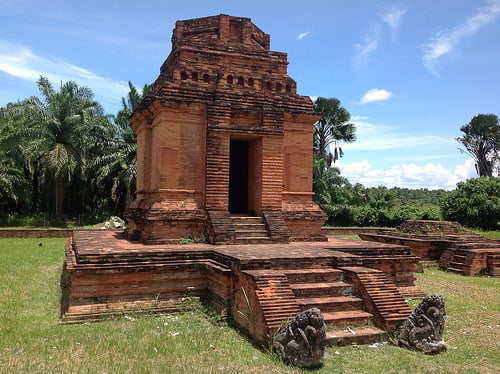Candi Bahal, also known as Biaro Bahal or Candi Portibi are a group of Vajrayana Buddhist candis complex located in Bahal village, Padang Bolak, Portibi, Padang Lawas Regency, North Sumatra, Indonesia. The complex includes three candis: Candi Bahal I, Candi Bahal II, and Candi Bahal III. The temple site is linked to the Pannai Kingdom circa 11th to 13th century CE.
Shrine’s History
Candi Bahal is one of a group of temples discovered in Padang Lawas. Padang Lawas is a grassy flat plain located between the Barisan Mountains and the highlands of northern Sumatra. The plain is kept free of tall vegetation by the prevailing dry winds sweeping through the gap between the two highlands. There were no major settlements in Padang Lawas, but the area provided a strategic route for people moving between the east and west coast of Sumatra. The flow of people in the area might provide the reason for the establishment of 11th and 13th-century shrines found in the area. At least 25 brick shrines have been discovered in the plain of Padang Lawas, including Candi Pulo, Candi Barumun, Candi Singkilon, Candi Sipamutung, Candi Aloban, Candi Rondaman Dolok, Candi Bara, Candi Magaledang, Candi Sitopayan and Candi Nagasaribu.
No kingdoms were associated with these temples, at least according to inscriptions discovered on the site, however, the religion is identical to that practised by Adityawarman. Candi Bahal is the only temples that have been fully restored, the other were still in ruins. Construction of the temples of Padang Lawas was estimated to be between the 11th to 13th century CE. They were possibly linked with the Pannai Kingdom, one of the trading ports on the coast of Strait of Malacca under Srivijayan mandala. Restoration of Candi Bahal I occurred in 1977-1978 and 1982-1983. Candi Bahal II has been restored between 1991-1992.
Architectural Relevance of This Shrine
The three temples of Bahal are separated by a distance of about 500 meters. The complex of the temple is known locally as biaro, possibly indicating a clue to its original use. The names of three of the Bahal temples indicate connections with Nepal and Sri Lanka. Bahal is a term still used in Nepal to refer the two-storied temples of the Vajrayana, a major sect which influenced Buddhism in Indonesia. Rampant lions carved flanking the temple of Biaro Bahal I was similar to carvings at Polonaruva, the 11th-century capital of Sri Lanka. The complex is the largest in North Sumatra. All three temples of Bahal were constructed of red bricks, while the sculptures were constructed of sandstones. Each temple is surrounded by a perimeter red brick wall about 1 meter thick and 1 meter tall. A gate on the eastern wall provide entrance gateway into the temple; the gate is extended outward with 60 cm tall walls on both sides. The main temple of each complex is located in the centre.
By RoadThe nearest Bus stop is Medan.By RailThe nearest Railway station is North Sumatra.By AirThe nearest Airport is modern Kuala Namu International Airport was opened on July 25, 2013, and is located almost 40 kilometres from Medan.
